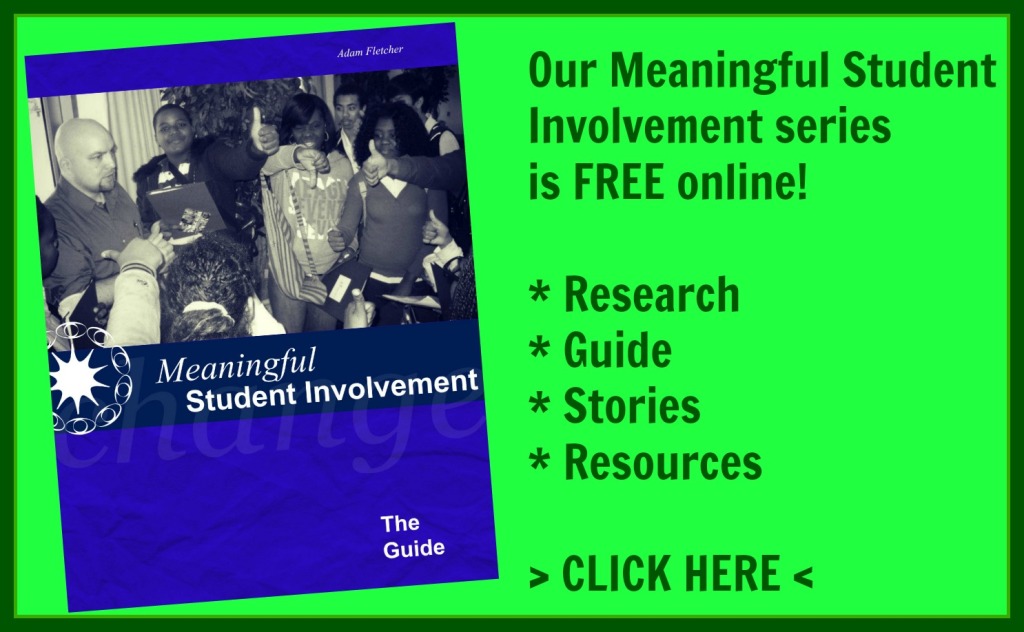
Meaningful Student Involvement can include opportunities for students as school planners. Following is an introduction to these roles, some details, stories and resources.
Introduction
Education planning happens in many different avenues, with several different considerations. Students can be partners in planning throughout education, whether selecting textbooks, determining classroom behavior guidelines, or participating in the physical design process for a new building. There are two forms of Meaningful Student Involvement in school planning.
Engaging students as partners in education planning illustrates how a variety of everyday school activities, including building design, curriculum development, personnel management, personal learning plans, can embody Meaningful Student Involvement. I am not talking about oft-told stories of students planning dances or fundraisers either. Instead, this chapter concentrates on students writing curricula, designing new school buildings, and developing programs affecting entire state education systems. That is how Meaningful Student Involvement improves education for all learners.
Effects on Education
Through my research and experience, I have learned that education planning can have global effects on students. Rather than just affecting them students who are directly involved, engaging students as partners in education planning can affect all students in the particular environment the planning affects. (Rigolon, 2011) Through education planning, every student in every school can have opportunities to positively participate in, gain from, and affect schools. Many educators and research studies have shown me that Meaningful Student Involvement in planning requires training and reflection in order to meaningfully validate and authorize students to create change. It also inherently requires the participation and investment of those most affected; this means that taking time to educate students about their involvement ensures successful planning.
One of the very realistic challenges to engaging students in school improvement is identifying their motivation for participating. Some students might be participating in education planning activities simply to earn credit or for other external factors. Whatever their reason for participating is, when activities meet the characteristics of Meaningful Student Involvement, any student can experience the benefits of meaningful involvement.
Meaningful Student Involvement engages students as education planners by ensuring that they know what, how, why, where, when, and how effectively they are learning. This includes students designing curriculum, planning the school day, co-creating new school designs, or other activities that build upon their experience, education, ideas and opinions.
Places for Students as Education Planners
Places in schools that can engage students as educational planners include:
- Classrooms: Students co-design curriculum with teachers; create project-based learning opportunities for themselves and their peers; and set personal learning goals.
- Administration: Students develop policy development or adjustment recommendations; students participate as full members in the formal school improvement process.
- Culture: Teachers and students co-create classroom behavior standards; teachers participate in professional development settings to learn student/teacher partnership activities.
Stories of Students as Planners
Following are stories of students as planners throughout schools. They feature classroom settings, building-wide approaches, whole district activities and more.
- Writing Curriculum
- Engaging Students on Purpose
- Students Involved in School Design
- Planning High School Learning
- Action through PICI
- Learning Units for Teachers
- Students Launch a School
- Elementary Students Revise Curriculum
Considerations for Students as Planners
As many schools grapple with the need for effective school transformation practices, few are actually asking their primary constituency: the students. Later in this book you can read about the closely related topic of Meaningful Student Involvement in education decision-making, including students on school boards and school site councils. However, the future of Meaningful Student Involvement in education planning includes student participation on school improvement teams and in state, district, and local school program planning processes. These opportunities will ensure the sustainable and effective influence of students in schools into the future by creating important avenues for students to impact the school classes, programs, and other activities that affect them the most.
Asked recently about Student/Adult Partnerships focused on improving the elementary school she leads, principal Donnan Stoicovy of State Park, Pennsylvania said this about students as planners:
“…[I]t should not be what we think they should know. It should be what the kids want to know. Besides that, teachers do not have all of the answers or knowledge. Together, as teachers and students, we accomplish so much more together. Having that openness to learning from each other and engaging in deliberation to solve problems is so important for the survival of a democracy. It is the gift we can give to our students and our future.” (Dzur, 2013)
Connecting student-led planning to democracy is the key to Meaningful Student Involvement.

You Might Like…
- Strategies for Meaningful Student Involvement
- Meaningful Student Involvement Toolbox
- Meaningful Student Involvement Students as Partners in School Change
References
- Evans, R. and Anthony, J. (1991 June). “Active learning: Students and the school budget process,” The Social Studies. 56-61.
- Grace, M. (1999). “When students create the curriculum.” Educational Leadership, 57 (5) 71-74.
- Gordon, R. (2003) “Want safe schools? Put the kids in charge!” Classroom Leadership 7(2): 6-7.
- Knowles, T. and Brown, D. (2000). “Chapter 5: Student designed curriculum,” in What Every Middle School Teacher Should Know. Westerfield, OH: National Middle Level School Association. Kordalewski, J. (1999). Incorporating student voice into teaching practice. ED440049. Washington, DC: ERIC Clearinghouse on Teaching and Teacher Education.
- Wehmeyer, M., Sands, D. (eds.) (1998). Making it happen: Student involvement in educational planning. Baltimore, MD: Paul H Brookes Pub Co.
DO YOU HAVE STORIES, RESOURCES OR OTHER INFORMATION TO SHARE ABOUT STUDENTS AS PLANNERS? LEAVE YOUR INFORMATION IN THE COMMENTS BELOW OR CONTACT SOUNDOUT.

